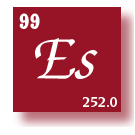
History (Albert Einstein) Einsteinium, the seventh transuranic element of the actinide series to be discovered, was identified by Ghiorso and co-workers at Berkeley in December 1952 in debris from the first large thermonuclear explosion, which took place in the Pacific in November, 1952. The 20-day 253Es isotope was produced. (Albert Einstein) Einsteinium, the seventh transuranic element of the actinide series to be discovered, was identified by Ghiorso and co-workers at Berkeley in December 1952 in debris from the first large thermonuclear explosion, which took place in the Pacific in November, 1952. The 20-day 253Es isotope was produced. In 1961, enough einsteinium was produced to separate a macroscopic amount of 253Es. This sample weighted about 0.01Mg and was measured using a special magnetic-type balance. 253Es so produced was used to produce mendelevium (Element 101). In 1961, enough einsteinium was produced to separate a macroscopic amount of 253Es. This sample weighted about 0.01Mg and was measured using a special magnetic-type balance. 253Es so produced was used to produce mendelevium (Element 101).
About 3Mg of einsteinium has been produced at Oak Ridge National Laboratories by - irridiating kilogram quantities of 239Pu in a reactor for several years to produce 242Pu,
- fabricating the 242Pu into pellets of plutonium oxide and aluminum powder,
- loading the pellets into target rods for an initial 1-year irradiation at the Savannah River Plant, and
- irradiating the targets for another 4 months in a HFIR (High Flux Isotopic Reactor).
The targets were then removed for chemical separation of the einsteinium from californium. IsotopesFourteen isotopes of einsteinium are now recognized. 254Es has the longest half-life (275 days). PropertiesTracer studies using 253Es show that einsteinium has chemical properties typical of a heavy trivalent, actinide element. |

